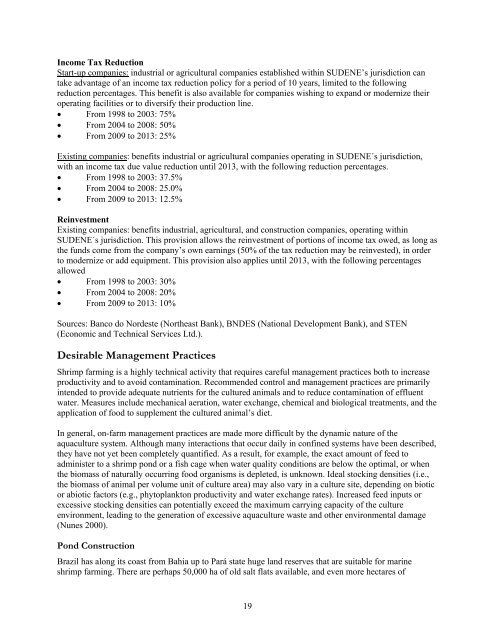Shrimp Farming in Brazil: An Industry Overview - Library - Network of ...
Shrimp Farming in Brazil: An Industry Overview - Library - Network of ...
Shrimp Farming in Brazil: An Industry Overview - Library - Network of ...
Create successful ePaper yourself
Turn your PDF publications into a flip-book with our unique Google optimized e-Paper software.
Income Tax Reduction<br />
Start-up companies: <strong>in</strong>dustrial or agricultural companies established with<strong>in</strong> SUDENE’s jurisdiction can<br />
take advantage <strong>of</strong> an <strong>in</strong>come tax reduction policy for a period <strong>of</strong> 10 years, limited to the follow<strong>in</strong>g<br />
reduction percentages. This benefit is also available for companies wish<strong>in</strong>g to expand or modernize their<br />
operat<strong>in</strong>g facilities or to diversify their production l<strong>in</strong>e.<br />
• From 1998 to 2003: 75%<br />
• From 2004 to 2008: 50%<br />
• From 2009 to 2013: 25%<br />
Exist<strong>in</strong>g companies: benefits <strong>in</strong>dustrial or agricultural companies operat<strong>in</strong>g <strong>in</strong> SUDENE´s jurisdiction,<br />
with an <strong>in</strong>come tax due value reduction until 2013, with the follow<strong>in</strong>g reduction percentages.<br />
• From 1998 to 2003: 37.5%<br />
• From 2004 to 2008: 25.0%<br />
• From 2009 to 2013: 12.5%<br />
Re<strong>in</strong>vestment<br />
Exist<strong>in</strong>g companies: benefits <strong>in</strong>dustrial, agricultural, and construction companies, operat<strong>in</strong>g with<strong>in</strong><br />
SUDENE´s jurisdiction. This provision allows the re<strong>in</strong>vestment <strong>of</strong> portions <strong>of</strong> <strong>in</strong>come tax owed, as long as<br />
the funds come from the company’s own earn<strong>in</strong>gs (50% <strong>of</strong> the tax reduction may be re<strong>in</strong>vested), <strong>in</strong> order<br />
to modernize or add equipment. This provision also applies until 2013, with the follow<strong>in</strong>g percentages<br />
allowed<br />
• From 1998 to 2003: 30%<br />
• From 2004 to 2008: 20%<br />
• From 2009 to 2013: 10%<br />
Sources: Banco do Nordeste (Northeast Bank), BNDES (National Development Bank), and STEN<br />
(Economic and Technical Services Ltd.).<br />
Desirable Management Practices<br />
<strong>Shrimp</strong> farm<strong>in</strong>g is a highly technical activity that requires careful management practices both to <strong>in</strong>crease<br />
productivity and to avoid contam<strong>in</strong>ation. Recommended control and management practices are primarily<br />
<strong>in</strong>tended to provide adequate nutrients for the cultured animals and to reduce contam<strong>in</strong>ation <strong>of</strong> effluent<br />
water. Measures <strong>in</strong>clude mechanical aeration, water exchange, chemical and biological treatments, and the<br />
application <strong>of</strong> food to supplement the cultured animal’s diet.<br />
In general, on-farm management practices are made more difficult by the dynamic nature <strong>of</strong> the<br />
aquaculture system. Although many <strong>in</strong>teractions that occur daily <strong>in</strong> conf<strong>in</strong>ed systems have been described,<br />
they have not yet been completely quantified. As a result, for example, the exact amount <strong>of</strong> feed to<br />
adm<strong>in</strong>ister to a shrimp pond or a fish cage when water quality conditions are below the optimal, or when<br />
the biomass <strong>of</strong> naturally occurr<strong>in</strong>g food organisms is depleted, is unknown. Ideal stock<strong>in</strong>g densities (i.e.,<br />
the biomass <strong>of</strong> animal per volume unit <strong>of</strong> culture area) may also vary <strong>in</strong> a culture site, depend<strong>in</strong>g on biotic<br />
or abiotic factors (e.g., phytoplankton productivity and water exchange rates). Increased feed <strong>in</strong>puts or<br />
excessive stock<strong>in</strong>g densities can potentially exceed the maximum carry<strong>in</strong>g capacity <strong>of</strong> the culture<br />
environment, lead<strong>in</strong>g to the generation <strong>of</strong> excessive aquaculture waste and other environmental damage<br />
(Nunes 2000).<br />
Pond Construction<br />
<strong>Brazil</strong> has along its coast from Bahia up to Pará state huge land reserves that are suitable for mar<strong>in</strong>e<br />
shrimp farm<strong>in</strong>g. There are perhaps 50,000 ha <strong>of</strong> old salt flats available, and even more hectares <strong>of</strong><br />
19

















